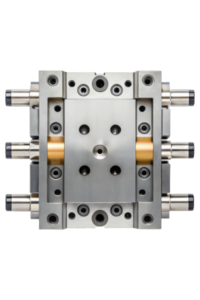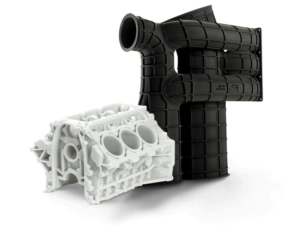Injection molding is an extremely popular manufacturing process, however, there are many subprocesses of injection molding that are often overlooked. Overmolding and insert molding are just two of these common subprocesses with a plethora of differences. Here, our team of experts outlines the processes of overmolding and insert molding to help you decide.
What is the Difference Between Overmolding vs Insert Molding?
Overmolding
Overmolding involves molding a material, typically a soft or elastomeric material like rubber or silicone, over a pre-formed substrate or part. This allows manufacturers to create parts from multiple materials or add necessary aspects of a different material easily. Overmolding is often used to provide additional functionality, improve aesthetics, or enhance grip and comfort.
This manufacturing method uses a two-stage process. A molten thermoplastic is injected into the shot, forming the rigid portion of the part. Then, another shot that is generally more flexible is injected in, on top of, or surrounding the rigid portion. The two separate portions bond together as they cool, creating a durable part.
Insert Molding
Insert molding is an injection molding process that forms plastic parts around other non-plastic parts, which are typically metal. This manufacturing process is commonly used to incorporate metal components such as threaded inserts, electrical contacts, or reinforcing inserts into plastic parts.
During the production process, the non-plastic part is pre-placed in the injection molding machine, and the molten thermoplastic is injected around the non-plastic part. As the thermoplastic cools, it forms a strong bond with the metal substrate, yielding a durable product.
How to Choose Between Overmolding vs Insert Molding?
When to Use Overmolding
There are many instances in which overmolding is the ideal manufacturing choice. Some of the best situations to use overmolding in are:
- Creating grips
- Improving aesthetics
- If your products need to have both a flexible and rigid portion
- If your product requires multiple layers
- And if your product does not need to be taken apart
When to Use Insert Molding
Insert molding also has a few instances where it is the preferred manufacturing choice, this includes:
- If you are using a non-plastic, prefabricated substrate
- Your product needs to be one solid part
- Or if you are looking to strengthen your part.
Common Applications of Overmolding and Insert Molding
Overmolding
The process of overmolding is used in various industries, for various products. Some of the most common industries where overmolding is used include aerospace, automotive, medical, industrial, and electronics. Common products include:
- Seating, switches, and handles for the aerospace industry
- Door panels, dashboard panels, handles, knobs, and controls for the automotive industry
- Surgical tools, medical instrument casings, and syringes for the medical industry
- Non-slip grips and protective layers for the industrial industry
- Encapsulating components and wires for electronics
Insert Molding
Insert molding is commonly used in the automotive, medical, and electronic industries. Some common applications include:
- Electrical sensors, gears, and fasteners for the automotive industry
- Defibrillators, medical cables, and wiring for the medical industry
- Cables, connectors, PCBs, and computer chargers for the electronics industry
Trying to Choose Between Overmolding vs Insert Molding? Quickparts Can Help
At Quickparts, we strive to create high-quality, on-demand solutions for our customers on a rapid timeline. We have the capabilities needed to take on both overmolding and insert molding projects, and we can help you determine which process is best for you. Plus, with our in-house 3D printing and CNC capabilities, our team can make most inserts needed for your processes.
Our services don’t stop there. We are able to take on CNC machining, SLA, SLS, direct metal printing, die casting, rapid prototyping, and more. With our best-in-class equipment and experienced team of professionals, we have everything it takes to get your products to you in a short turnaround time.
Ready to Get Started?
If you are ready to get started on your overmolding or insert molding project, contact our team today.


